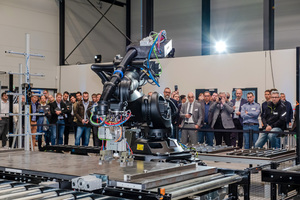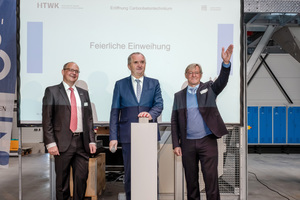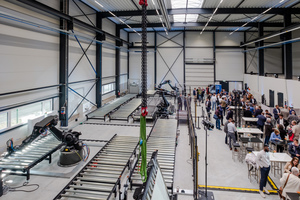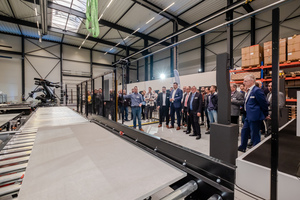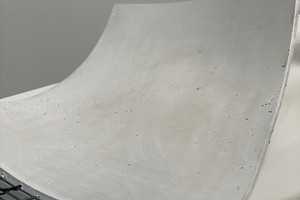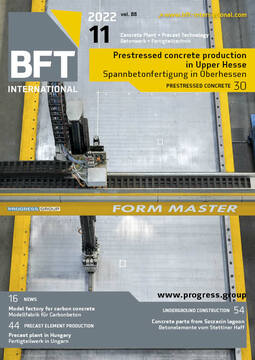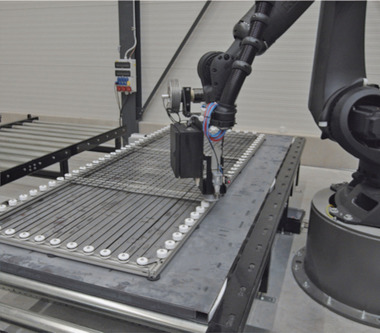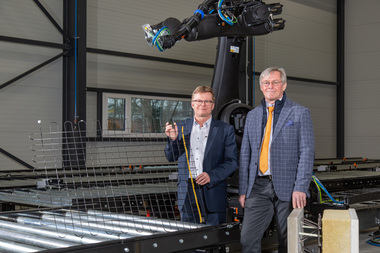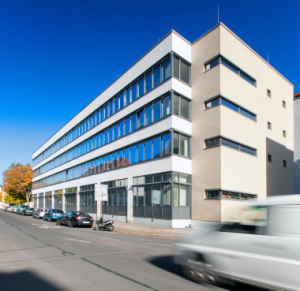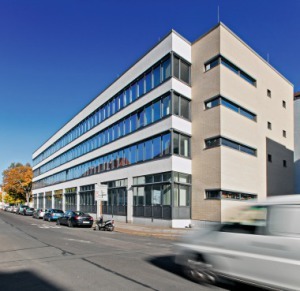Model factory for carbon concrete: HTWK Leipzig inaugurates Carbon Concrete Technology Center that is unique
Concrete is able to bear heavy loads, does not burn, is insensitive to external influences and cost-effective in production. Using steel as reinforcement, concrete can span considerable areas. The downside is an enormous consumption of raw materials and energy, let alone the greenhouse gas emissions. Carbon concrete can surpass the advantages of reinforced concrete (RC), while saving resources at the same time. To help pave the way for an accelerated wide application of the new composite material, a model factory – being unique all over the world – for the automated production of structural members made of carbon-reinforced concrete was now opened at the Leipzig University of Applied Sciences (HTWK Leipzig): The Carbon Concrete Technology Center covering a floorspace of about thousand square meters. The opening ceremony in Leipzig-Engelsdorf was attended by about one hundred representatives from industry, politics and science. Editor Karla Knitter took part on behalf of the BFT International.
Foundations for a digital, resource- and climate-friendly age
„A new chapter for future-proof construction is opened in Leipzig. Today, we inaugurate another flagship of Saxon engineering skills. The Carbon Concrete Technology Center is a Saxon brand mark – just as the Cube, the new world‘s first building made of carbon-reinforced concrete situated in Dresden. The unique model factory of HTWK Leipzig creates sound foundations for a digital, resource- and climate-friendly age on the construction site. I am glad about these innovations from Saxony. They are important for the construction industry and for the regional development in the Free State of Saxony,“ states Thomas Schmidt, Minister of Regional Development of the Free State of Saxon.
„HTWK Leipzig records the highest amount of third-party funds raised so far, amounting to more than 17.51 million euros, and thus being the most research intensive university of applied sciences in Germany. We are a strong partner in science, for the regional economy and are glad that the Carbon Concrete Technology Center provides us with another outstanding opportunity for joint research and the testing of innovations in an application-oriented way. In particular, our competences in the field of automation of manufacturing processes and our commitment for climate protection and sustainability come into effect in cooperations,“ says Prof. Mark Mietzner, Rector of HTWK Leipzig.
„At the Carbon Concrete Technology Center, we are researching which processes allow an efficient production of carbon concrete so as to manufacture structural members with ecological and economic benefits. However, even though carbon concrete and reinforced concrete are used in comparable applications, all production steps and machines need to be adapted to the new building material and in some cases have to be completely rethought,“ explains Prof. Klaus Holschemacher of the Structural Concrete Institute at HTWK Leipzig. „Here, we show construction companies how they need to design their manufacturing plants for producing building components made of carbon-reinforced concrete.“
Automated manufacturing saves resources and costs
Three industrial robots and 64 meters of roller tables in the Carbon Concrete Technology Center provide for an automated production process of components being up to 3.125 m wide and 1.25 m long. A crane can remove the finished components from an especially developed tilting table. The areas of concrete placement and quality inspection that are currently being set up are scheduled for starting operations early 2023.
The Leipzig-based scientists are very proud of one particular innovation: A robot is manufacturing the carbon reinforcement at the Carbon Concrete Technology Center on site individually. For this purpose, the robot arranges the carbon fiber yarn, within a few minutes, in a grid pattern resulting in exactly the geometry that is required for a specific component. A huge progress: So far, prefabricated carbon fiber meshes with standard dimensions are almost always used in carbon applications. They have to be cut to size or combined for the actual application. „By direct yarn placing, we do not only avoid unnecessary transportation, but also save up to 40 percent of the expensive and energy-intensive carbon fiber material. As a result, the production costs of carbon concrete components drop to the level of comparable high-performance reinforced-concrete components,“ predicts Otto Grauer, research assistant at the Structural Concrete Institute of HTWK Leipzig.
Model factory ensures new innovations
The researchers in Leipzig regard direct yarn placing as a key technology because it also allows the integration of useful functions such as heating elements or sensors into the structural member directly. „Once a robot has placed the grid structure for the reinforcement of the component, it could place an additional structure made of carbon fiber yarn at a specific position in the future, thus reproducing a capacitive sensor. Whoever touches the building component later at this place could turn the light on or off – similar to using a touchscreen, without using any switch at all,“ states Tobias Rudloff, the research assistant of the Institute for Process Automation and Embedded Systems at HTWK Leipzig. Visions like this can be tested at the Carbon Concrete Technology Center and implemented in the application. Five research projects with a total funding volume of 2.5 million euros are currently being carried out for the further development of carbon concrete construction.
The Carbon Concrete Technology Center was supported by the Federal Ministry of Education and Research as well as the Free State of Saxon as part of Germany‘s largest construction research project C³ – Carbon Concrete Composite. The inauguration was an item on the agenda of the carbon- and textile-reinforced concrete days in Dresden organized by the C³ association.
Background
The construction industry uses about 40 percent of raw materials extracted all over the world. Moreover, about one-third of the total greenhouse gas emissions are attributable to the construction, use and dismantling of buildings. Reinforced concrete (RC) with a volume of more than 100 million cubic meters used in construction annually is the most important building material in Germany. Components made of carbon concrete are many times thinners and lighter, while featuring the same performance, compared to those made of reinforced concrete. In this way, not only less concrete is needed and thus less cement, gravel, sand and water, but also considerably less energy for production, transport and logistics.
CONTACT
HTWK Leipzig, Forschungskommunikation
Dr. Rebecca Schweier
Karl-Liebknecht-Straße 132
04277 Leipzig/Germany
+49 341 3076-6385

